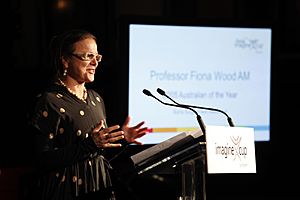Fiona Wood facts for kids
Quick facts for kids
Fiona Wood
AO FAHMS
|
|
|---|---|

Wood speaking at the Microsoft Australia Imagine Cup 2012 announcement in Sydney
|
|
| Born |
Fiona Melanie Wood
2 February 1958 Yorkshire, England
|
| Nationality | Australian |
| Occupation | Plastic surgeon |
| Known for | Spray-on skin |
| Spouse(s) | Tony Kierath |
Fiona Melanie Wood (born 2 February 1958) is a famous Australian plastic surgeon. She is a specialist in treating severe burns. Dr. Wood works in Perth, Western Australia.
She leads the burns unit at Royal Perth Hospital. She also directs the Western Australia Burns Service. Dr. Wood is best known for helping to create "spray-on skin". She developed this amazing treatment with Marie Stoner. Dr. Wood is also a professor at the University of Western Australia. She leads the Fiona Wood Foundation, which supports research.
Contents
Early Life and Education
Fiona Wood was born in Yorkshire, England. Her birthday is 2 February 1958. She was the third of four children. Her father was a miner, and her mother was a physical education teacher.
Her parents wanted their children to get a good education. Fiona went to Ackworth School in West Yorkshire. As a child, she loved sports. She even dreamed of becoming an Olympic sprinter!
In 1978, she was one of only twelve women accepted into medical school. She studied at St Thomas's Hospital Medical School in London. She graduated in 1981, becoming a doctor.
Career and Medical Research
Dr. Wood worked at famous hospitals in London. These included Great Ormond Street Hospital. Later, she married Tony Kierath, a surgeon from Western Australia. In 1987, they moved to Perth with their first two children.
She continued her training in plastic surgery. She also had four more children! In 1991, Dr. Wood became the first female plastic surgeon in Western Australia.
In 1993, she started working with scientist Marie Stoner. They focused on improving burn treatments. Their work helped to greatly reduce the time needed to grow new skin. It also helped to reduce permanent scars for burn victims.
Helping Bali Bombing Victims
In October 2002, Dr. Wood became widely known. Many survivors of the 2002 Bali bombings were sent to Royal Perth Hospital. She led a team that worked to save 28 patients. These patients had severe burns, infections, and shock.
Her dedication and skill helped many people. In 2003, she was recognized for her work. She was named a Member of the Order of Australia. In 2005, she was named Australian of the Year. This is a very high honor in Australia.
In March 2007, a plane crashed in Indonesia. Dr. Wood traveled to Yogyakarta to help. She assisted with the emergency medical care for burn patients there.
In 2022, a book about her life was released. It is called Under her Skin by Sue Williams. Dr. Wood's share of the money from the book goes to the Fiona Wood Foundation.
Developing Spray-on Skin
Dr. Wood is famous for her invention: spray-on skin. This treatment helps burn patients heal faster. It is still being improved today.
Before, growing enough skin cells for major burns took 21 days. Dr. Wood's method reduced this to just five days. She found that using thinner skin helped. This skin took less time to prepare.
Her research showed that scars are much smaller if new skin is applied quickly. Getting the wound closed within 10 days greatly lowers the risk of infection. Infections are a big cause of severe scarring. Dr. Wood's main goal is "scarless woundless healing."
Dr. Wood started a company called Avita Medical. This company helps make the spray-on skin treatment available. The idea for her company came after a teacher had severe burns in 1992. Dr. Wood worked with scientist Marie Stoner to save his life. They worked nights in a lab.
They started by growing skin sheets. Then, they found a way to spray skin cells onto the burns. This made them pioneers in their field. The company began in 1993. It can now grow small skin samples into larger amounts of skin cells in just five days. Surgeons in other cities, like Sydney and Auckland, use this service. The cells can even be flown in and ready the next day. Money from licensing this technology goes back into research.
Awards and Recognition
- From 2005 to 2010, Dr. Wood was voted the most-trusted Australian. This was in a Reader's Digest poll.
- She is considered an Australian Living Treasure.
- In 2004, she won the Western Australia Citizen of the Year award. This was for her work in burns research.
- In 2015, Dr. Wood became a Fellow of the Australian Academy of Health and Medical Sciences.
- In 2024, she was promoted to Officer of the Order of Australia. This was for her excellent work in plastic surgery, research, and as a mentor.

